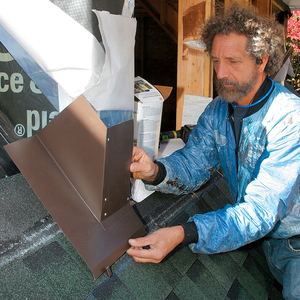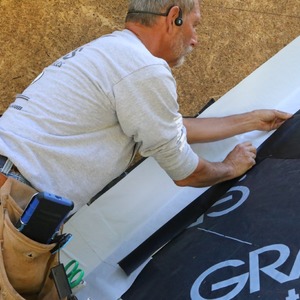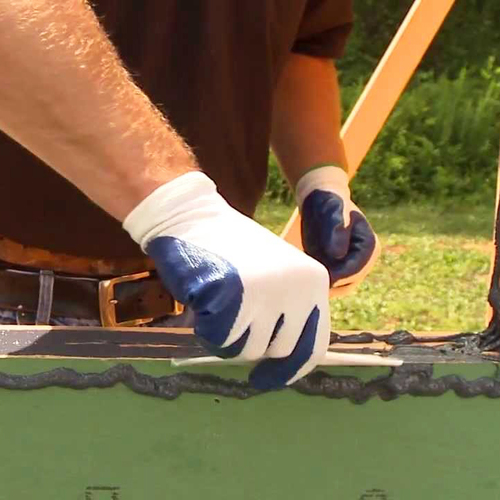
Of all the construction-related topics that young builders need to master, one of the most confusing is flashing. If you don’t yet have much job-site experience, you’ve probably got loads of questions: Where do I need to install flashing? What materials should I use? How do I know if a particular product is appropriate or durable enough for a certain application?
It takes many years to understand proper flashing techniques. I have never come across a comprehensive guide to flashing; that book has not yet been written. (That said, my 2003 edition of Architectural Graphic Standards for Residential Construction has an excellent chapter on flashing.)
In light of the fact that flashing manufacturers come out with new products every year, most students of flashing practices will have to make do with a variety of cobbled-together resources, articles, and videos to master this subject.
Flashing has changed in recent decades
We install flashing to prevent rain from entering a building through cracks. Most of the cracks that require flashing are found where dissimilar materials meet — for example, where a chimney meets roofing, where roofing meets a wall, or where siding meets a window — or at the exposed perimeter of surfaces like roofs and walls.
Originally, flashing was made of sheet metal. When I got my first job as a roofer in 1974, peel-and-stick products did not yet exist — or if they existed, they were still unknown on most job sites.
The roofing company I worked for used four kinds of flashing: galvanized steel for drip-edge flashing, aluminum for step flashing on asphalt shingle roofs, copper for most purposes on slate roofs, and lead for chimney counterflashing.
Many (but not all) types of metal flashing include a bend in the sheet metal to direct water in a certain direction — generally, away…
Weekly Newsletter
Get building science and energy efficiency advice, plus special offers, in your inbox.

This article is only available to GBA Prime Members
Sign up for a free trial and get instant access to this article as well as GBA’s complete library of premium articles and construction details.
Start Free TrialAlready a member? Log in















31 Comments
It is amazing how much damage can be done if the kickout flashing is not executed properly. The bottom of windows is also high on the list of neglected details.
Doug,
I'd say at least half of the new houses I see here rely on a blob of caulking rather than kick-out flashing - and I've never seen it on an old one.
Edit for rambling anecdote: In the late '80s I worked on a condo project where the builders neglected various flashing details, including omitting kick-outs. The results were that even before the units were sold, problems in the building assemblies were becoming evident. The developer went bankrupt, the only occupant (his mistress) had to move out, and the last I was of him was driving his jaguar filled with suitcases on the highway out of Ottawa. A cautionary tale.
Malcolm,
I have a saying, "only the crooks retire early from the building business". You have just confirmed it.
Doug,
Below are two photos showing damage caused by the lack of kickout flashing.
I can confirm on 4 corners of a breezeway on a nationally registered home. Kick out flashing is well rather important. Unless you like cutting out custom cypress siding and removing long leaf pine studs.
Any info on flashing windows with integral j channel for vinyl siding? The industry standard at least around here is shoty tape on all four sides.
Matt,
Any window needs a fully flashed rough opening before the siding work begins -- regardless of the type of siding involved. The J-channel is decorative trim; it has nothing to do with the flashing.
To flash a rough opening, you need:
- Sill pan flashing with a slope or a back dam.
- Jamb flashing that overlaps the sill pan flashing.
Then the window is installed. Next comes head flashing (peel-and-stick or metal) with the WRB lapping over the head flashing.
Secondary jamb flashing is a good idea, especially for finned windows.
Martin,
Maybe im just misinterpreting what your saying. To clarify when I install a window with integral J channel I cut the wrb correctly, wrap it into to the jambs and over the 5 degree or so sloped sill. Then a peel and stick sill pan and tape/ peel stick the jambs. Leave the top flap of wrb up for a peel and stick head flashing then put wrb flap over head flashing and tape seams.
With the integral j channel im not using a metal head flashing that covers the window casing with drip edge like it is illustrated. Just want to make sure this is a best practice, i have never seen an integral j channel with a metal head flashing. I suppose its a more robust install but the details are more complicated to where i would just install a window without integral j channel but it does make a vinyl job cleaner and esier in my opinion.
By secondary jamb flashing do you mean taping the nailed flange to the wrb?
Matt,
You're right -- with integral J-channel at the head, you won't use metal flashing at the head -- you'll use peel-and-stick.
Q. "By secondary jamb flashing, do you mean taping the nailed flange to the WRB?"
A. Yes -- although the type of product you'll use is best called "flexible flashing," not tape. (I'll admit that there is a gray area between the two product categories -- flexible flashing and tape.)
And here's one I've been hired to fix. That is, when all this snow dissolves. Every thing below is all rotted. Not just one problem... but a host of possible solutions.
I would like to add this warning.
Do not mix metals when flashing. Galvanic action will cause premature corrosion.
My roofer used galvanized nails to secure some aluminum flashing. The nails caused the aluminum to corrode through in about 5 years.
Ken
Ken,
That's a good point, but I don't think I've ever seen anything but galvanized nails used on pre-finished aluminum flashing. Galvanized steel and aluminum are right next to each other on the galvanic scale.
A similar materials compatibility issue is aluminum flashing on a brick chimney. My understanding is that the alkalinity of the bricks and/or mortar will eat the aluminum. So lead or copper is recommended. Lead easier to work with and is common in New England, but in my opinion, it should no longer be used because of its toxicity. So that leaves copper, but it can be hard to find someone to do copper. The supposedly top-notch roofer my GC hired to do copper flashing on my chimney used aluminum for the hidden parts and copper for the visible parts: a recipe for rapid galvanic corrosion. Ended up doing it myself with the help of a smart carpenter with lots of related experience.
The right solution is really to follow Martin's advice to get rid of any masonry chimneys, which are a heat leak anyway. I wish we'd done that.
Charlie,
You're right -- these days, it's hard to find a roofer who does good copper flashing work.
If GBA readers are interested in my old article on chimneys -- the one Charlie seems to be referring to -- here is the link: "Farewell to the Chimney?"
Ken,
Climate and installation details will affect whether the situation you describe -- the use of galvanized roofing nails to secure aluminum flashing -- will lead to problematic galvanic corrosion.
The worst case would be using a galvanized nail and leaving the nail head exposed to the weather. A good roofer would never do this. Once a roofer's work is complete, the nail heads should be invisible.
Remember, galvanic corrosion requires moisture. If the nailhead is dry, the galvanic corrosion process will be very slow. If the nailhead is wet, the corrosion will be faster.
For more information on this topic, see "Understanding Galvanic Corrosion and How to Avoid it in Metal Roofing."
One final point: You can buy aluminum roofing nails and copper roofing nails from a good building supply house. Using roofing nails that are made of the same metal as the flashing you are installing is certainly best practice.
So does GBA have any resources on the subject of the first comment -- "kickout flashing" ?? I've never heard the term, but it sounds like this is referring to the end of the eave where a roof edge butts against a wall. I own a duplex that has a garage roof butting against a 2nd story wall. It seems to be properly flashed along the wall/roof intersection, except when it gets to the eave the gutter is unable to catch the water running down along the wall/roof intersection and instead it runs down the siding and probably behind the siding as well. I could see this was a problem such that I "invented" a piece of flashing that curled out from the wall to deflect the water into the gutter. I'm wondering what is the proper way to do this job? Does GBA illustrate it anywhere? or maybe the other resource websites?
Dennis,
Here is an illustrated guide to kick out flashing: https://hammerandhand.com/best-practices/manual/6-roofs/6-1-kick-flashing/
Thanks Malcolm. Those are some pretty detailed instructions. Good website.
It's very good of Hammer and Hand to have made their manual publicly available. Great resource!
Dennis,
I'm glad that Malcolm helped you. You might also notice that there is a link I provided at the end of my article to a relevant resource -- this one: "Kickout Flashing: How to Flash Troublesome Roof-to-Wall Intersections."
My article also provided a link to the online version of the Hammer & Hand manual.
How do you decide between a flat flashing end leg, a kickout type end leg, and the end leg pictured at the top of the article/and my 3rd attachment where it lays flat against the face of the trim for a bit and then kicks out.
Is there an appropriate application for all three, or are these three different options for the same thing with varying levels of effectiveness?
It seems the third option is best for water table trim, window head trim, belly bands... i just done see them mass produced and sold at lumberyards or Home Depot.
Kevin,
The function of the kick-out shown in your first and third variants is to stop water making its way back underneath by capillary action. If you use the flat end leg, you need to size the flashing so that leg sits at least 3/16" out from the surface underneath, which will accomplish the same thing.
Image 3 example doesn't need any capillary break or space between it and the face of the trim then? Can the vertical leg that runs against the vertical face of the trim then be tight up against the trim, or even touching, since it has a kickout at the end? Or is it still good practice to leave a small air gap of 1/16”-1/8” or so...
Kevin,
Q. "Image 3 example doesn't need any capillary break or space between it and the face of the trim then?"
A. Not to my knowledge.
Q. "Can the vertical leg that runs against the vertical face of the trim then be tight up against the trim, or even touching, since it has a kickout at the end?"
A. Yes. That's common.
Q. "Is it still good practice to leave a small air gap of 1/16 inch to 1/8 inch or so?"
A. There shouldn't really be any need for drainage or ventilation drying at this gap, so I'm not sure why you are worried.
Kevin,
In general, flashing with a kickout lip is best. You want the water to drip away from the building if possible. If there is no kickout lip, you can be certain that the water will dribble down the vertical surface below.
If you look at existing buildings, you'll notice a lot of examples of visible stains on vertical surfaces where this type of dribbling has occurred. It's ugly; it causes stains; and it can lead to rot.
Roof overhangs protect siding. Heavy head casing protects windows. Flashing with a kickout lip protects head casing. And so on.
Almost done now that the weather was dry for 3 days; first time! No kick out, many holes in step flashing, cedar siding directly on tar paper. Bad news all around. Had to pull up 30 sq. Ft. of shingles as the garage sheathing was rotted as well. Ugh. Now air tight and happy north wall.
Cause for concern?
Flashing just delivered for skirt board that will be around entire perimeter and vertical leg against face of trim is not parallel to it. Is this a concern safety-wise (depth of protrusion), or just more aesthetic?
Is it recommended to have this vertical leg be parallel to face of trim in general - it’s easy to have this fixed at the flashing supply place...
Entirely aesthetic.
Anyone ever hear of priming or painting or coating somehow the sheared edge of a z-flashing? Especially on custom order z flashing where they will shear a smaller strip off a wider sheet. For instance, all of the legs that are the exposed legs on my z flashings (not behind siding) are the sheared edge legs. Over time, wouldn't rust streaks show up on white trim?
maybe no one thinks much about this because often the painters will come behind and just spray it. But what about if you don't have that luxury... And yes i am talking about the actual 24 gauge edge, not the 1/2" leg. Hopefully this makes sense...
Kevin,
Flashing typically has a hem bent onto edges that will be exposed. But no, I've never seen anyone site-dress the edges of flashing. There are cuts made on very piece of flashing that gets installed, and I've never seen them rust.
Kevin,
I've never heard of a reason to cut (or shear) the bottom leg of Z-flashing. It is usually installed as it comes from the factory.
Needless to say, the answer to your question depends on the metal you have specified. Neither copper nor aluminum will rust. If you are talking about painted steel, there is a theoretical chance that exposed steel will rust -- but I've never seen it happen.
Log in or become a member to post a comment.
Sign up Log in